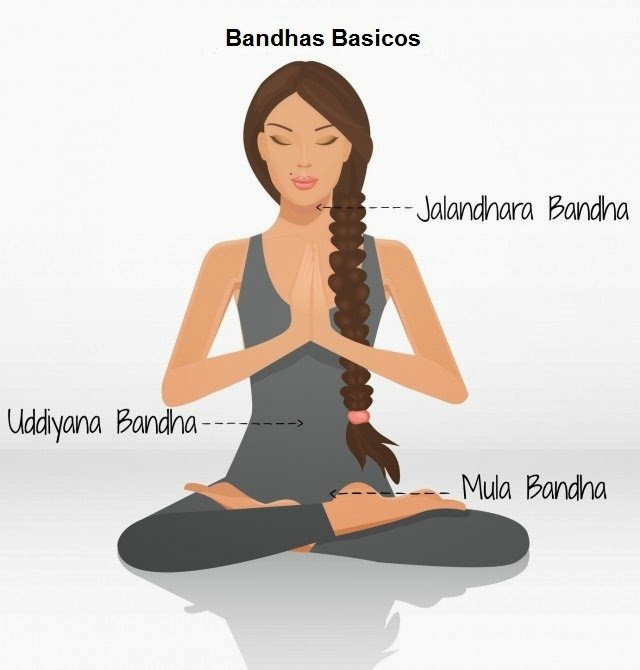Many yoga practices are related to the fundamentals of the human
being, with strength and vital energy. In this space we will focus on
one of the most significant practices of Yoga: Bandhas. Know what it
is, how they are practiced and all the beneficial effects they bring
to the organism and health.

What are the Bandhas?
The word "bandha" means lock, lock or key. It is a term related to the action of squeezing, contracting, closing or blocking certain areas of the body to activate the flow of Prana. It is a set of yogic practices that are very important to carry out successfully the exercises of Pranayama and Hatha Yoga.
Bandhas blocks are psychoenergetic, yogic techniques designed to increase and redirect the flow of pranic energy to the central channel. They create an energetic support for the body and support the postures from the inside. They can support the body physically, protecting the sacroiliac and lumbar region of the spine, lengthening the latter and opening the rib cage.
During practice, the internal organs are massaged and stimulate the endocrine system. Physiologically, they promote respiration and circulation, while the neurological effects stimulate the central nervous system and create a sensation of relaxation and well-being.
How does energy work in the body?
The function of the Bhandas is directly linked to the current of energy of the body. When it is stabilized and focused, it awakens the Kundalini energy, and goes up through the spine. In this way, it passes between the energy centers called Chakras, unlocking possible energetic and emotional knots. At this point is when a sense of well-being and a state of full consciousness occurs.
Bandhas and Hatha Yoga

In the practice of Hatha yoga, most techniques have an effect on our subtle energies. However, to increase its effects, it is necessary to use the Bandhas, with contractions designed to block the energy body.
Once sealed, the energies will not be wasted, but reoriented towards a useful goal. The concentrated fire of the energies can be used, first, to strengthen health and then to achieve the states of meditation so desired by many yoga practitioners.
During meditation, the bandhas help to release the knots of energy flow, purify parts of the being from where the feeling of negativity arises, where emotions lodge and rot, slowing down and preventing progress towards other aspects of life.
Main bands
Mula Bandha (Root Key)
This Bandha is located in the sexual organs. To activate it, it is necessary to strengthen the muscles around the anal sphincter. The contraction of the sexual muscles, at the same time as the navel and the rectum, makes the Mula Bandha activate. The movement can be practiced after the inspiration or after the exhalation and consists of contractions in four points:
Anal sphincter
Sex organs
Low abdominal muscles
Navel towards the spine
In practice there is a sensation of swaying caused by an internal massage that stimulates the energies that are entangled in the sexual organs, the navel and the rectum. The excess of sexual energy that is produced is diverted into creative energy until the Muladhara chakra is stimulated. These massages also extend to other organs such as the liver, kidneys and spleen.
The practice of this Bandha improves digestion and skin problems. It provides calmness and is very useful for after delivery, because it reactivates this area of the perineum. It is also used to prevent urinary incontinence.
Uddiyana Bandha
Located at the level of the diaphragm. It compresses the solar plexus, but also the digestive organs, the adrenal glands, the pancreas and the kidneys. The practice of this bandha tones the digestive system. It causes a large production of energy in the abdomen and chest. This energy has healing and toning properties and reinforces the feeling of well-being.
The Uddiyana Bandha acts directly on the sympathetic nervous system, strengthening it and improving it. It allows its control so that it does not activate in inappropriate situations. This can help control stress and anxiety. On the subtle level, this bandha stimulates the Manipura chakra, located in the solar plexus, flooding it with vital energy.
To apply Uddiyana Bhanda you must adopt a sitting position, standing or leaning on your back. After expiring, the abdomen retracts and shows completely flat.
The most used is the standing position, with legs slightly apart and knees bent. The hands should be placed on the thighs and the fingers inside with the elbows bent. The bust leans forward and the shoulders are vertical to the knees.
It is not recommended to apply this bandha on a full stomach.
Jalandhara Bandha (Key to the throat)
It consists of stretching the throat pulling the spine to the brain. The term Jala refers to the brain and the nerves that pass through the neck, and dhara means "upwards". It is said that this bandha has a subtle effect on the pituitary and pineal glands.
The action of extending the neck forward, bringing the chin closer to the chest, has an effect on the thyroid, the parathyroid glands and on the thymus. This stimulates the spinal cord's parasympathetic region, which regulates heart rate, respiration and blood pressure. Finally, this band compresses the carotid sinus, which controls blood pressure.
The practice of this bandha stimulates the Vishuddha chakra in the throat, flooding it with vital energy. This lock improves the pranic flow in the sushumna.
To practice the Jaladhara Bandha, it is necessary to press the chin against the sternum. This bandha is used especially for postures like that of the candle (Sarvangasana).
Its practice is done especially after inspiration, the practitioner
must sit comfortably in a posture with crossed legs, hands on knees
and with a straight spine. Usually, this Bandha is performed by
singing or meditating.
Maha Bandha (the great Key)
This technique consists in the simultaneous practice of the three main bands, during which the breath must be contained after expiring, with a perfect posture and a state of total concentration.
To carry out this Bandha, one must:
- Inhale deeply and exhale completely through the mouth.
- Hold the breath.
- Place your hands on your knees.
- Lift the shoulders and tilt the upper part of the body forward slightly, keeping the back straight.
- Perform Jalandhara Bandha and concentrate on the Vishuddha Chakra.
- Perform Uddiyana Bandha and concentrate on the Manipura Chakra.
- Finally, perform Mula Bandha and concentrate on the Muladhara Chakra.
- Stay in this position, with the three Bandhas maintained, while breathing can be easily maintained.
- Finally, the Bandhas are released in the same sequence in which they were adopted.
- Then he inhales deeply and very slowly until he returns to the initial position.
- Breathing usually remains for some time in this last position.
Before approaching the Bandhas practice, the breathing techniques of the previous levels should be practiced regularly for a long time, to have a mastery of the technique and to be able to acquire all the benefits. Of course, it is always advisable to start your practice under the supervision of a qualified guide.
I hope you found it interesting and if you dare to put it into practice, tell me about your experience.
HAVE A NICE DAY!
Thank you for reading and review!
